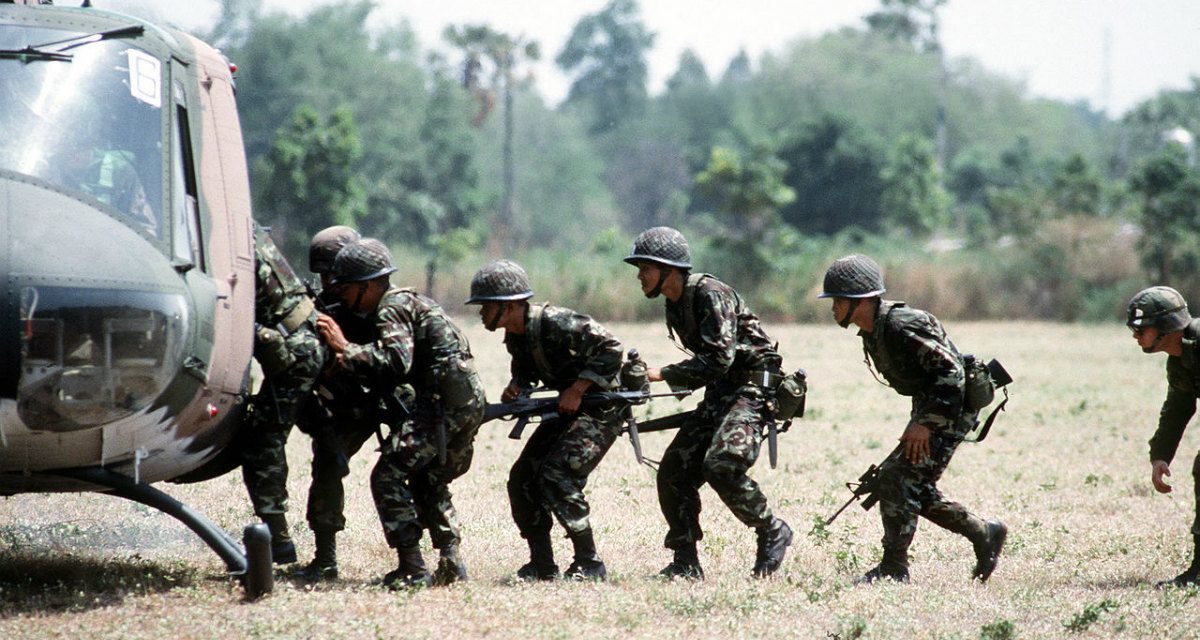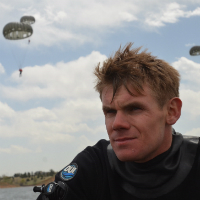On its opening weekend in 2011 The Hangover II gave almost $86 million worth of Americans a taste of Thailand. We cheered as The Wolfpack let loose in Bangkok. After dropping their bags at the Phulay Bay Ritz Carlton, they hit the city like American GIs in the 1960s: cavorting with prostitutes and slamming Singhas. Monkeys, monks, and mobsters stood between Stu and his wedding. Fortunately, they stayed away from Thailand’s southern Pattani region where insurgents killed five people a week that year.
Away from Bangkok’s glitz, Thailand hides its success combating insurgency. Between 1965 and today, the Kingdom of Thailand defeated two insurgencies and continues to suppress another in the south. These insurgencies are serious. Support from China and Thailand’s neighbors enabled the first, a communist insurgency during the Cold War. It leapt from 126 annual deaths in 1967 to 1,590 in 1970. As the communist insurgency concluded in the early 1980s, Thai officials assert that 80,000 fighters and family members accepted government amnesty and reintegrated into Thai society. The government next faced the first Pattani insurgency from 1980 to 1998, ultimately reducing it to criminal mischief. But it would later be reignited, creating a third insurgency for the government to contend with, and conflict has raged since 2004. This latest insurgency, though, is different from the two the government managed to bring to an end. Improvised explosive devices strike civilian targets and insurgents fight against a government without the political will to resolve the conflict. A 2015 report from West Point’s Combating Terrorism Center described it as “the single most lethal conflict in Southeast Asia, with nearly 6,400 dead and 11,000 wounded” since 2004.
To combat this series of insurgent threats, the Royal Thai Army first mimicked British techniques from the Malayan Emergency, but found them wanting. With the escalation of French and later American operations in Vietnam, the Thai government then experimented with American search-and-destroy techniques. Not until the Thai government embraced a unique, national form of counterinsurgency—characterized by military supervision of democratizing reforms, amnesty, and development—did they succeed. Still, despite developing organic techniques, Thailand struggled like other countries to overcome internal division when insurgent challenges presented themselves. Institutional military resistance has also stymied efforts by counterinsurgent-minded officers to dust off their playbooks until local confrontations became national crises.
In The Thai Way of Counterinsurgency, Dr. Jeff Moore analyzes three Thai insurgencies to see what lessons they might hold for counterinsurgency. He finds that the Thai government uses “a decisive strategy of politics leading the military and staunch coordination to drive forward their [counterinsurgency] operations.” Others agree. In 2016, the Central Intelligence Agency’s in-house journal, Studies in Intelligence, published an article that concluded that rather than “brute force . . . amnesty, repatriation, and jobs” were crucial to Thai success against the communists. Likewise, in 2016 the Council on Foreign Relations’ policy recommendations for the ongoing Pattani insurgency recommend Thailand revisit its previous successes and bring back senior officers involved in the 1980–1998 insurgency, largely mirroring the recommendations made by US Army Col. Michael Fleetwood in 2010. Period articles from the Central Intelligence Agency’s archives highlight the importance of Thailand’s “political-military offensive” to the success of Thai counterinsurgency.
The Thai Way of Counterinsurgency explores three Thai counterinsurgency campaigns through the lens of what the author terms a “COIN Pantheon” framework. This framework tweaks David Kilcullen’s inter-agency counterinsurgency framework by shifting its focus from defeating to explaining counterinsurgency campaigns. Dr. Moore overlays this framework on campaigns against the communists from 1965 to 1985, southern insurgents from 1980 to 1998, and the ongoing southern Pattani insurgency since 2004. Each section begins by discussing the conflict’s prelude and principle actors. Profiles of the conflict’s at-risk populations and insurgency follow. Each chapter concludes by exploring how government organs cooperated in an effort to defeat the insurgency.
In the conclusion, Dr. Moore describes Thai counterinsurgency’s unique characteristics. At the strategic and operational levels, he finds that Thai counterinsurgency differs from the recommendations of well-known counterinsurgency theorists like David Galula and Sir Richard Thompson, in terms of the robust role of the military leadership and an especially prominent emphasis on diplomacy. While both Galula and Thompson advocate for civilian-controlled counterinsurgency, the military has governed Thailand on behalf of the monarch throughout most of the period being examined—except for rare occasions of civilian control. Thailand’s counterinsurgency campaigns prevailed when military leaders planned and executed operations with support from police and civilian agencies. These national military leaders then synchronized diplomacy to undercut external support from China and sanctuary in Malaysia. At the tactical level, Thai counterinsurgency used large-scale irregular forces, the Thahan Phran, supported by special operations forces, massive local indoctrination efforts, and offers of amnesty. Moore’s conclusions provide insight into the adaptability of counterinsurgency techniques, but break little ground beyond FM 3-24’s first two chapters, which summarize factors associated with counterinsurgency success and how to integrate civilian organizations.
My biggest critique of this book is one of validity. In the introduction, Dr. Moore aims this book at both academia and security practitioners, but fails to deliver something meaningful to either party by never demonstrating the similarity of the conflicts or suggesting what types of conflicts the Thai way of counterinsurgency may apply to. According to the Uppsala Conflict Data Program, only the communist and ongoing Pattani insurgencies meet their definition of an active insurgency, meaning that the 1980-1998 case fails to qualify. Likewise, the Council on Foreign Relations article mentioned earlier does not acknowledge the 1980-1998 southern campaign as a counterinsurgency effort. Additionally, the communist insurgency presented an existential threat to the Thai monarchy in every region, while the southern insurgencies raged only in the three southernmost provinces. It is not immediately clear we can generalize lessons from three different conflict types into a Thai way of counterinsurgency. With his generalized lessons only tentative, I’m not sure where I should apply them. As a military dictatorship in a Buddhist country headed by a revered monarch with strong alliances, Thailand may be a unique case. Though he implies his conclusions apply universally, Dr. Moore undermines this conclusion by never addressing internal or external validity.
The second critique of this book relates to its usability. Despite writing a much more usable thesis, Dr. Moore’s The Thai Way of Counterinsurgency poorly identifies conclusions, fails to mark sections in a useful way, and leaves readers with an index unusable for non-experts in Thai insurgency. In a nearly 450-page book, Dr. Moore devotes only the last twenty pages to conclusions. Chapters end abruptly with discussions of how development fit into each campaign without a summary of each campaign’s lessons learned or even the key events. The lack of summary forces a close read, but poor section marking further challenge the reader. Below the chapter level, all organizational cues are marked with the same typeface and size, forcing the reader to flip pages to determine a section’s place in the broader narrative. Poor structure could be overcome with an effective index, but The Thai Way of Counterinsurgency fails here, too. The index contains no entries for “borders,” “government,” “ideology,” or other counterinsurgency concepts. I picked up Dr. Moore’s book to further my research into maritime insurgencies, but had to read the entire book to find information pertaining to “maritime,” “smuggling,” or “boat.” Poor structure and usability will likely doom this book to obscurity.
Even with the Thai Way of Counterinsurgency’s problems, the book contains victuals of value. As a foreign internal defense practitioner, I will not forget Thailand’s Village Scouts, experience with amnesty, and education reform. The Village Scouts took Boy Scout-style indoctrination to Thailand’s masses, instilling national pride and faith in the Thai monarch. In each village, scouts countered insurgent propaganda with nationalist messages and recruited others to join them. The Thai government coupled nationalist indoctrination with amnesty. However, amnesty works only when society will accept returning fighters and the government protects surrendered them. Pattani fighters accused of terrorism have so far been excluded from government amnesty programs, preventing reconciliation of hardcore insurgents. Many southern insurgents studied and radicalized in illegal pondok Islamic schools. To stem the flow of insurgents, the government integrated pondok into the Thai educational system, marginalizing radicals and training southerners in practical skills beyond their traditional study of Islam. This lesson seems immediately applicable to Afghanistan, where Afghan and Pakistani madrasas radicalize Afghan fighters. The Thai government’s success in co-opting insurgent grievances and practice offers important techniques for consideration in counterinsurgency elsewhere.
As the US Army shifts from counterinsurgency towards decisive action, we can take heart in knowing that we are making the same mistake we made after Vietnam and Thailand has made at least twice. Each time an insurgency challenged the Thai state, the army and government sought to crush the insurgency with sweeps and repression until national leaders recognized the problem and empowered skilled counterinsurgency practitioners. Russian and Chinese hybrid warfare make counterinsurgency and foreign internal defense likely missions for American advisors both in Europe and, nearer Thailand, across Southeast Asia. While The Thai Way of Counterinsurgency offers an important counterpoint to American doctrine influenced heavily by Western experience, we might better go to the source to read Gawin Chutima’s The Rise and Fall of the Communist Party of Thailand.
Image credit: Tech Sgt. Joe Coleman, US Air Force


